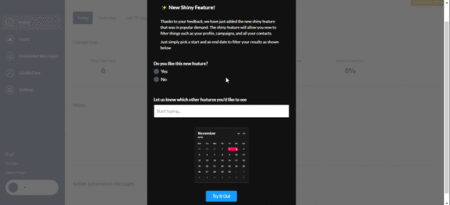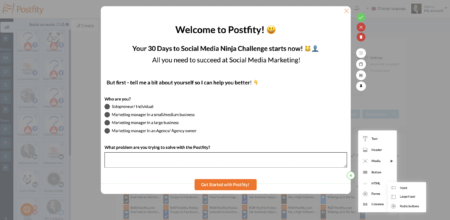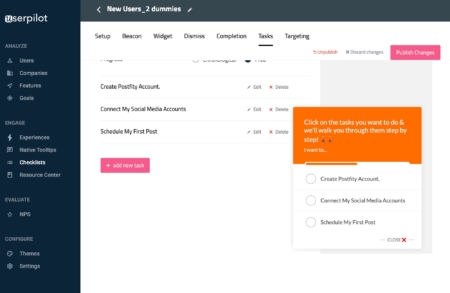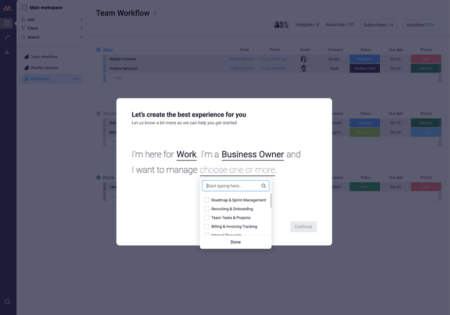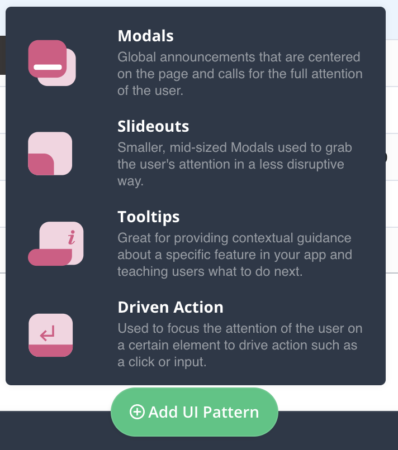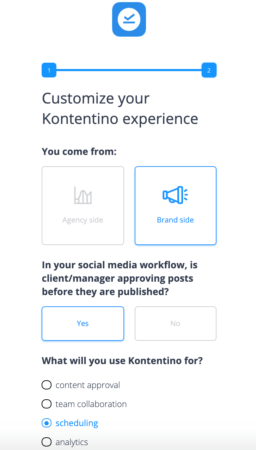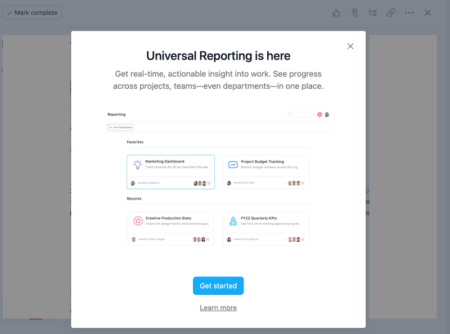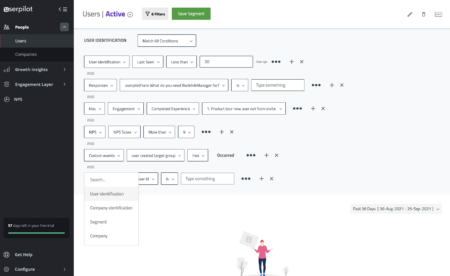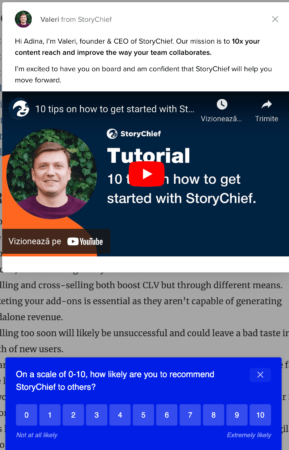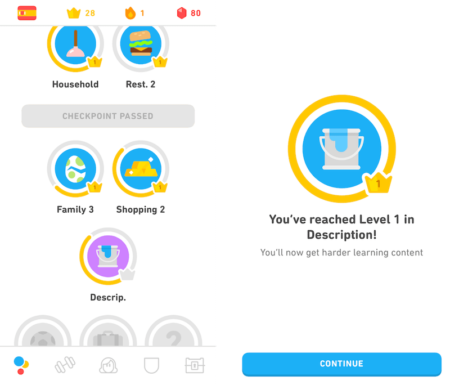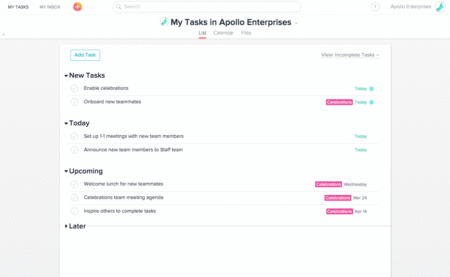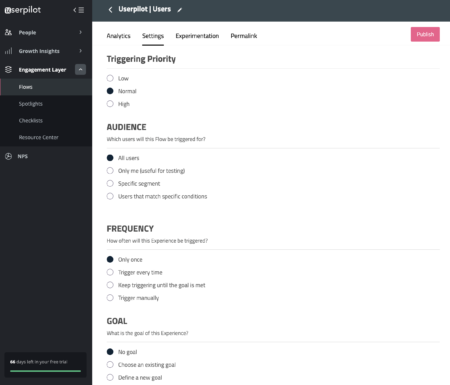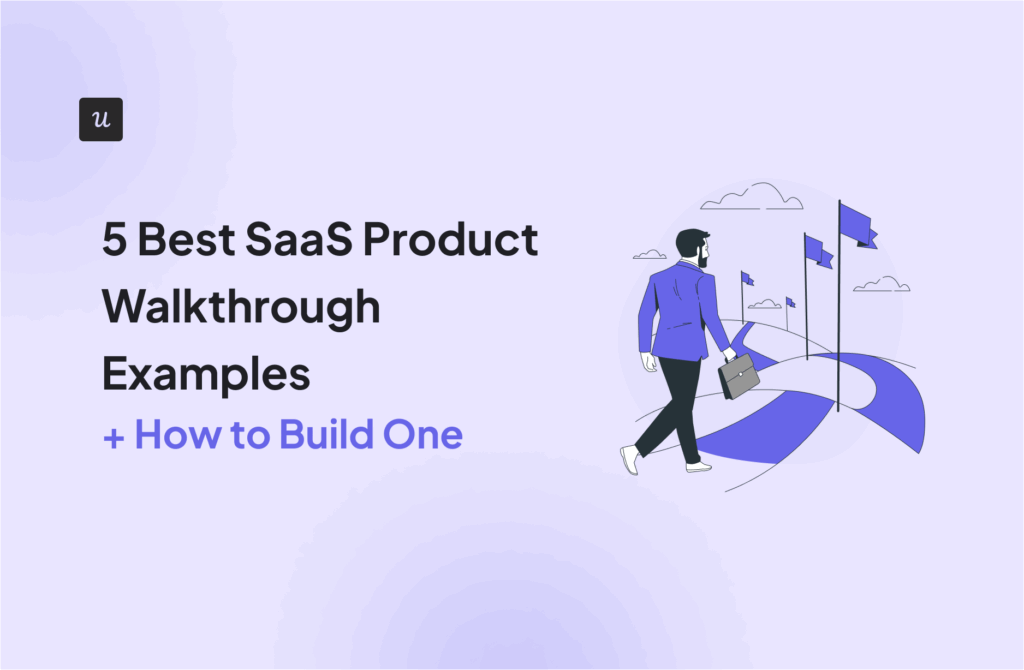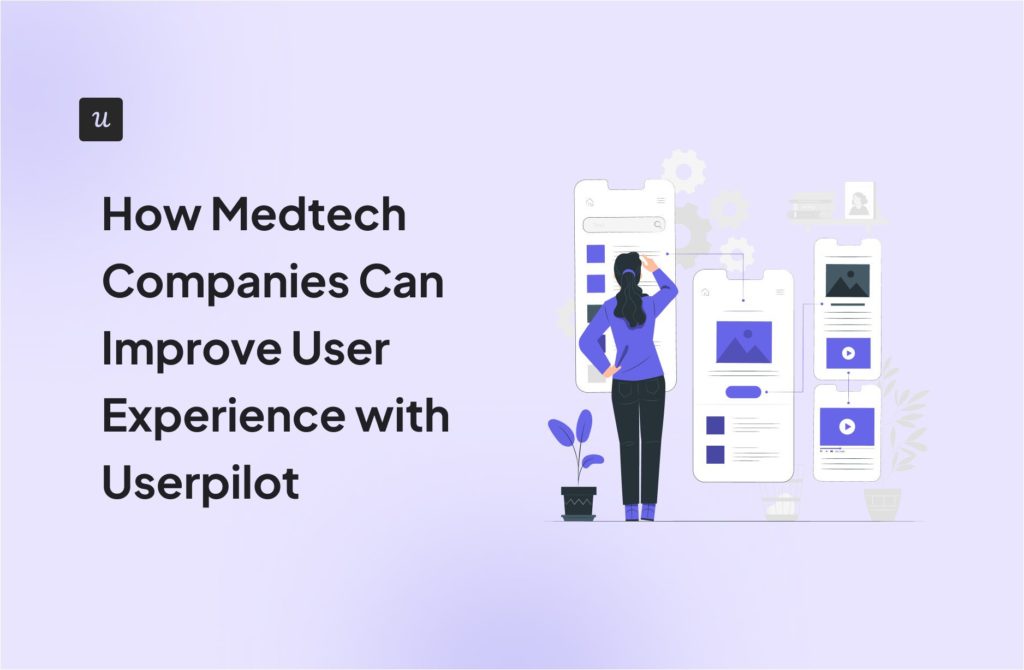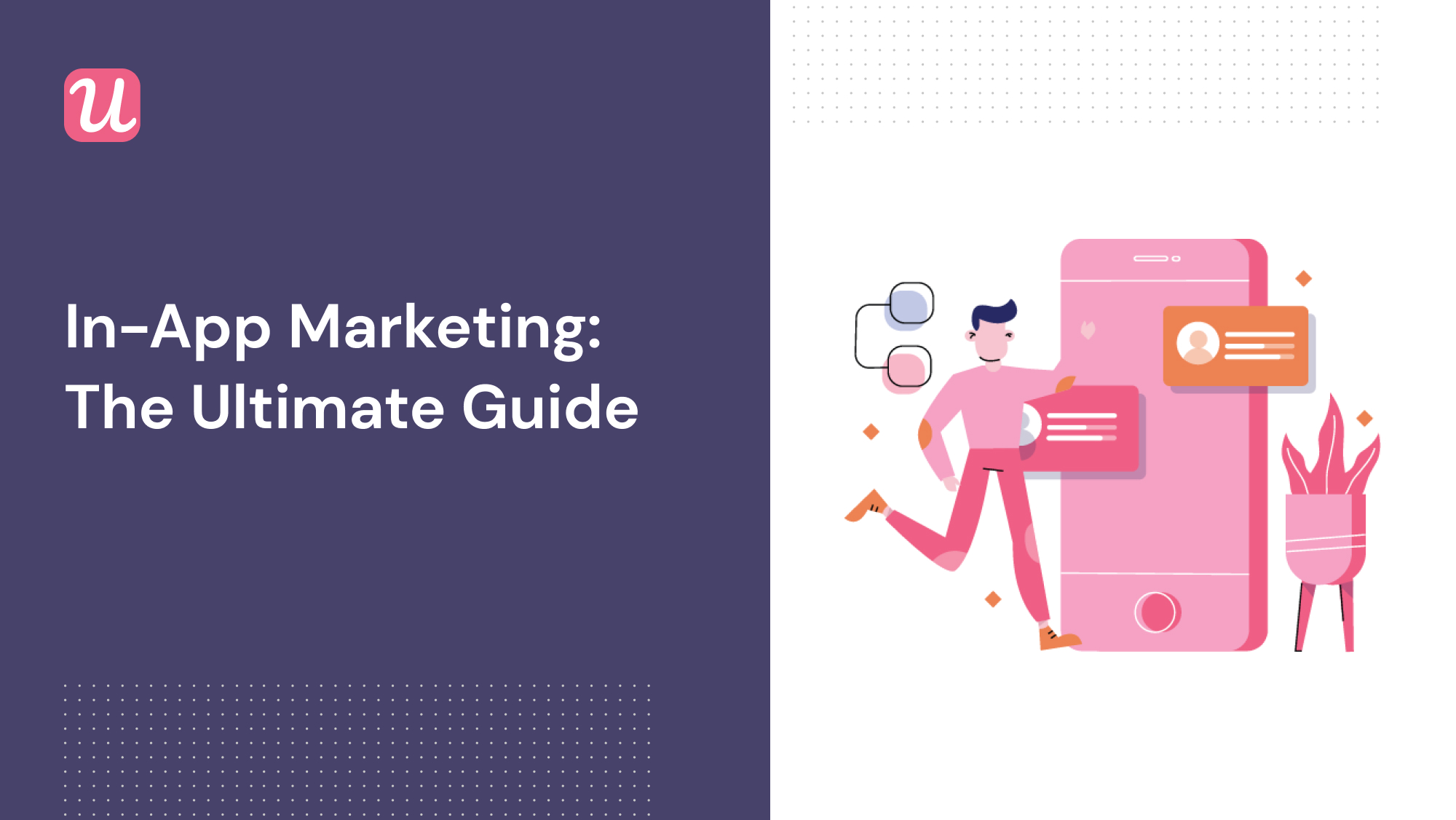
The Ultimate In-App Marketing Guide for Product Marketers in 2024
In-app marketing: everyone’s doing it in bits and pieces.
What if you could promote key features, upsell to your users, and gather invaluable feedback, all inside your product?
In this guide, I’m going to explain why in-app marketing is so important, and how you can use it to improve engagement and product adoption.
Let’s dive in!
Get The Insights!
The fastest way to learn about Product Growth, Management & Trends.
In-app marketing guide for product marketers (short summary)
- In-app marketing describes the practice of communicating with your users inside the app using contextual and timely app messages
- Use in-app messages to improve the user experience, collect and act on feedback and communicate in a contextual way
- Types of in-app marketing messages: notifications, tooltips, interactive walkthroughs, modals, checklists, micro-surveys, micro-videos, in-app guides
- Set up your strategy by defining a marketing goal, choose your tool stack, measure and analyze success, and A/B test different messages
- Use in-app messages to increase feature adoption, convert trial users into paying customers, launch new features, drive account expansion, collect user feedback
- Use onboarding tools for in-app marketing and send contextual messages
What is In-App Marketing?
In-app marketing describes the practice of communicating with your users inside the app using contextual and timely app messages, aimed at guiding the potential users on how to use the app after the user acquisition stage.
In-app messages are used both in SaaS and mobile app marketing and allow product marketers to send timely and personalized messages that help users use the app.
Why do you need an in-app marketing strategy? What are the benefits of in-app marketing?
In-app marketing messages can act as a force multiplier that complements existing product marketing elements and aims for the same goals.
Where email marketing and push notifications may struggle to find the right time, in-app messages only trigger at the most opportune moments.
Timing is certainly everything as Localytics found out when their research showed in-app notifications more than triple user retention.
Here are some other benefits that this antidote to churn has to offer:
1. Improve your user in-app experience
Taking a product-led approach to the in-app experience can truly differentiate your solution and boost your trial to paid conversion rate.
Using messages in-app you can improve the user experience by:
- Removing friction
- Explaining new features through interactive tutorials
- Providing quick access to customer support or knowledge base resources inside the app
- Showing users how to get more value out of the product
2. Gather insights from in-app user feedback
In-app marketing can help you understand who your users are and what they struggle with — both of which are paramount to providing a service that makes them stick around.
Whether it’s which features they like most, how easily they’re able to use the product, or the tasks they’re trying to accomplish, all these insights can be collected with in-app microsurveys.
Collecting insights in-app helps you make data-driven decisions when it comes to improving your product.
3. Act on feedback in real-time
If you don’t give your users a voice then you won’t be able to identify nor correct any issues they may be having with your product. Undiagnosed problems will, in turn, lead to a high churn rate that eats away at your user base over time.
Feedback tools like Userpilot can save your product from this grim fate by sending out churn surveys that arm you with the knowledge needed to improve the customer experience.
4. Shift to contextual communication that is relevant for the user
In-app marketing gives you the power to control when app messages are triggered and for who. This makes it far easier to provide a contextual onboarding experience built around specific app user personas.
Targeted marketing like this is extremely difficult to pull off through other channels like email, push notifications, or social media since narratives that may appeal to one user persona could feel totally irrelevant to another.
Using in-app messages empowers you to get as specific as you want.
Types of marketing in-app messages
In-app messaging can come in a variety of forms. While they’re all useful in the big picture, it’s best to be mindful of their unique strengths and weaknesses.
In-app notifications
There are two types of notifications that you can use.
You have push notifications, that pop up on your computer or phone screen. These are designed to attract users back to your product.

You also have in-app notifications. These are far more subtle and are only visible when a user opens the app.
Chances are, the vast majority of your customers aren’t using every single feature of your product. This is bad because it means they aren’t getting as much value from your product as they could be.
A lack of value means your users may look elsewhere, or not be able to justify paying for your product.
In-app notifications offer a simple way of educating your users about specific aspects of your product. This ensures they stick around.
The best way to understand how to use in-app notifications is with an example. One of the best examples is Slack.

As you can see, Slack occasionally gives users a notification in the top-right corner of the app. It’s a little gift box that entices the user to click. After all, who doesn’t love gifts?
Once clicked, it opens up a feed of the latest features that have been added to Slack.
This is a fantastic way of alerting users to new features.
You can also use notifications to direct users’ attention to existing features that haven’t seen much adoption.
Spotify uses a neat little banner that appears at the top of the screen when a user takes a certain action.

The notification alerts the user to an aspect of Spotify that they may not have known about. The tip will differ depending on the context.
A final interesting example comes from Drift.

Most customers will approve permission requests due to the fear of missing urgent notifications.
They actually ask their users if they’re allowed to send them notifications in their browser of choice.
That way they can market to their customers using notifications in an app their users are likely to use on a daily basis.
In-app messages using tooltips
Tooltips are often associated with the onboarding engagement process but they can be just as useful to your in-app messaging strategy.
Tooltips are often used in a chain reaction with the next one appearing to guide the active users after they complete the previous action. This makes for an interactive yet easy-to-follow experience that can flatten the learning curve for new users.
Here’s an example from Facebook on how you can use tooltips for your in-app marketing:

When Facebook released the ability to download photo albums, they included a tooltip that explains how to do it. The tooltip is contextual and appropriately timed; only appearing when the user is most interested in the feature.
Another example is how Github introduces its users to extra functionality they might not have known about through the use of tooltips:

In-app interactive walkthroughs
When combining multiple tooltips in a sequence, you get an interactive walkthrough.
Traditional product tours may be popular but they’re generally inferior to interactive walkthroughs. While both are forms of in-app guidance, product tours are inherently flawed in that they dump a pile of information on the app user in a single sitting, damaging the user experience.
On the other hand, interactive tours allow users to gradually learn by doing which greatly increases the odds that they’ll retain what they’ve learned.
In-app modals
In-app modals pop up on a user’s screen and make them perform a target action before letting them go forward. Modals are notorious for irritating users. When implemented correctly, however, they can be incredibly effective.
Modals usually require an action from the user. This can either be a CTA that directs them to a certain feature or setting or simply a message that needs to be dismissed.
The welcome screen is the most common form of modal in the SaaS world.
Here’s an example of a welcome screen from the social media scheduling app Postfity:
Hubspot has even combined micro-videos (which we’ll talk about later on) with modals to promote a feature :

When you try to access a feature you aren’t currently paying for, you’re shown this modal. From an upselling point of view, this is great.
In-app checklists
Checklists are very powerful partly due to the Ovsiankina effect — the inclination to continue uncompleted tasks once you’ve started them. This encourages users to go from one step to the next until they achieve success/reach the activation point of their journey.
By nudging users to complete the set of actions that lead to activation, you’ll be able to increase customer satisfaction and reduce churn. Every product has a different activation point so let’s use Postfity as an example:
- create an account
- connect a social media account
- schedule the first post
Just like tooltips, you can create checklists through Userpilot in just a few minutes without the need for coding.
In-app micro surveys
Microsurveys are a friendlier way of collecting feedback and data since they’re not as daunting to users as those long, boring surveys sent via email.
The feedback you gather can give you insight into the customer’s goal, role, JTBD, and other helpful information that will make it easier to personalize their journey and drive engagement.
In the micro survey below, Monday manages to get three invaluable data points without coming off as intrusive to users:
In-app micro videos
Micro videos are usually around 30 seconds in length and aim to educate or excite. While not a substitute for longer-form video content, these can highlight the value of your product in bite-sized chunks to keep users interested and increase engagement.
You can also use micro-videos in a modular tutorial format to make adoption easier for new users. This plays off the fact that customer education is an effective method of raising retention rates.
In-app guides/resource centers
Tying a knowledge base into your in-app marketing strategy can help cut down on the number of support tickets your customer service team will have to deal with.
The information in a knowledge base can be far more in-depth than anything explained in tooltips and, with 91% of respondents saying they’d be willing to use one, what have you got to lose?
Or more importantly, what do you stand to gain?
Well, a Coleman Parkes survey found that introducing a self-service knowledge base can increase retention rates by as much as 85%. Lastly, Harvard Business Review actually found that 81% of users try to solve their software issues before seeking help so why not let them?
How to set up your in app marketing strategy
Automation is an indispensable element of in-app SaaS marketing since it’s borderline impossible to remain contextual and timely if you’re handling everything manually.
Marketing automation software can also free product marketers from repetitive tasks which gives them more opportunities to create value elsewhere.
Let’s have a look at how uniting strategy and tools can make your in-app marketing campaign a success.
1. Define your marketing goal
Unless you have a comprehensive understanding of your own strategic direction, you won’t be able to deploy app marketing campaign tactics in a cohesive manner. Ask yourself some questions and determine the stage of the user journey you are trying to have an impact on:
- Do you have a churn problem?
- How do your users reach their “AHA moment” and can this be done quicker?
- How is your trial to paid conversion rate?
- Are you generating enough expansion revenue?
2. Choose your in app marketing tool stack
The reality is coding custom tools for everything isn’t going to be feasible for the majority of SaaS companies. Even with the financial considerations set aside, it would take up far too much of your development team’s time.
The time that could be spent on creating new features or improving existing functionality.
Fortunately, no-code tools like Userpilot let you implement in-app messages elements like:
- Interactive walkthroughs
- Knowledge bases
- In-app messages
- Microsurveys
- Tooltips
- Checklists
Most of these UI pattern elements can be created in a few minutes with just a handful of clicks.
Userpilot lets you create the experiences you need in a hassle-free, zero-code manner.
Adding product marketing tools to your strategy can also be beneficial as it makes it easier to analyze insights from customer data. For example, tools like Userpilot help you track feature usage of different customer segments throughout each stage in the customer journey.
Product marketing software can be paired with growth marketing software like Google Analytics that breaks down data into more manageable bits by segmenting conversion sources and tracking website/mobile traffic.
3. Measure and analyze in app marketing
While keeping an eye on SaaS growth metrics is always a good idea, there are other product marketing KPIs that you should stay aware of. These include customer acquisition cost, retention rate, revenue, and more.
When combined with user journey analytics, you’ll be able to get a holistic view of where your company stands as well as a clear projection of where it’s headed. One of the best ways to measure in-app marketing is through the zoom-in, zoom-out methodology.
The zoom-in analysis measures the performance of your tactics on a stage-to-stage basis while zoom-out analysis looks at the strategy’s impact on the customer lifecycle as a whole.
Viewing metrics from both angles can truly help you get an objective view.
4. A/B your in-app marketing messages
The best product adoption tools on the market have A/B capabilities and this is no coincidence. Constantly experimenting with different app marketing strategies, copy, and graphics is a pivotal step when trying to get better results out of your campaigns.
Each little tweak you make could either improve or detract from your goals but the only surefire way to know is through A/B testing. Userpilot lets you segment users so you can easily set up a control group.
This control group won’t receive any app messages which gives you a baseline to measure against.
You can also test different approaches across the two groups. For instance, if feature adoption is higher in the group that got a pop-up announcement versus introductory tooltips then you’ll know which approach is optimal.
Tests can also be done to optimize for other goals like reducing churn or applying psychological concepts.
When to use in app marketing?
Just because in-app marketing is so marketing that doesn’t mean you have to abandon your email effective campaign. In fact, the two work best when paired together. Emails can push users on the right path while in-app messaging ensures that they don’t see a confusing blank screen when they arrive in-app.
At the end of the day, not even the cleanest designs or most compelling copy will do your email marketing any good if other tactics aren’t in place to seal the deal.
Contextual email marketing is just one area where you can use in-app marketing to complement existing campaigns.
Other use cases are feature launches and onboarding since these are make-or-break moments that can heavily impact a customer’s perception of the product.
Let’s take a look at some examples to get a better feel for properly executing these strategies:
In-app marketing examples
In-app messaging is effective throughout all stages of the customer lifecycle. Whether you want to reduce friction in the onboarding process, promote a new feature, or have another goal in mind, the examples below can help you out.
Personalize onboarding
Onboarding is a critical element in the overall user experience because it’s your chance to make a good impression and display immediate value. Before you can start pursuing onboarding best practices, you need to realize that there are three phases of onboarding:
Pre-boarding
Coaching screens show up when you first open an app to briefly explain the core functionality and benefits. These often appear in a carousel format to make it easy for users to swipe through each slide.
On-boarding
Once the user has made it onto the main landing page, you can use tooltips and modals to walk them through each area of your product. This can consist of a linear product tour or interactive walkthrough depending on how much information needs to be delivered.
In-boarding
Also known as experiential learning, in-boarding is a less common strategy that seeks to give users helpful tips during the signup process to make it feel less tedious.
Of course, onboarding never truly ends since there’s always work to be done to optimize the user experience. This is why secondary onboarding has become commonplace, with many companies even going for tertiary onboarding and beyond.
Regardless of how many onboarding experiences you create, the important thing to remember is that every stage should feel personalized to the user. Try to get enough data to identify your persona early on as this will allow you to tailor the experience to their needs from start to finish.
Kontentino asks a few integral questions during onboarding so they can structure the process accordingly:
Building these types of welcome screens with a tool like Userpilot will make it easier to personalize and segment experiences
Increase new feature adoption
With all the time and money that goes into developing new features, the last thing you want is for all these resources to go to waste because customers don’t use them — not to mention the fact that retention can suffer if your otherwise valuable features aren’t being used.
Modals are a great way to announce new features but should be used in moderation.
In-app marketing helps you shine the spotlight on a new feature during its launch in a few ways. First of all, you could use in-app tooltip pop-ups that lead either to the feature itself or a list of the latest releases.
Another way to boost feature activation would be to combine your in-app messaging with social retargeting to bring their attention back to the platform. Finally, don’t be shy to announce new features on your login page since users likely see this screen on a daily basis — making it the ideal spot to encourage product adoption.
Help users reach the AHA moment and activate
The “AHA moment” is an emotional reaction in users where they suddenly grasp the true value of your product. To trigger this, you need to figure out the original reason they came to your product and deliver on their expectations.
We know that’s easier said than done but onboarding tools have significantly reduced the difficulty in triggering this epiphany. One trick that improves user activation is delaying email confirmation.
More often than not, forcing users to confirm their email before continuing can interrupt the natural flow of learning and run the risk of distractions halting the process.
Imagine putting all this effort into in-app marketing only for an email notification to snatch defeat from the jaws of victory. Creating milestones based on the user persona is another approach that can lay down a clear path toward that “AHA moment.”
That’s all users need, a clear path.
Drive customer expansion
Customer expansion describes the practice of creating more value for existing customers and, in return, bringing more value back to your company from those users as well.
Expansion is essential since it’s five times more expensive to acquire new customers than to retain existing ones.
The three main types of customer expansion are:
- upselling
- cross-selling
- add-ons
Upselling tends to be the most common of the three since convincing customers to upgrade to a pricier plan is a standard way to bolster your revenue. Here’s a great example from Slack:
In-app marketing tips and best practices
Use advanced segmentation
Customer segmentation is the pinnacle of an effective in-app marketing strategy. As your welcome screens and micro survey build up a repertoire of data, you need to start segmenting these customers so you can sort them by most valuable.
Segmentation also makes it easier to deliver compelling messaging. You can’t expect a single message to appeal to all users since every customer has different goals. By segmenting users based on what their needs are and where they are in their journey, your app messages can be hyper-targeted to appeal to specific personas.
The Userpilot advanced segmentation console was built from the ground up to serve as a rangefinder for in-app messages communication:
Be mindful of in-app marketing communication overlap
It might be tempting to use multiple CTAs in your app messages but throwing everything at the wall and seeing what sticks will be detrimental to your long-term results.
Instead, decide on which message you want the reader to focus on or which action you want them to perform. Here’s an example of what in-app messaging overlap can look like:
If you’re putting messages on an automatic trigger (especially if multiple messages are sharing the same page) then be sure to adjust the priority.
This prevents situations where active users are so overwhelmed by five messages at once that they end up ignoring all of them.
Enhance your in-app marketing with gamification
Gamification is the practice of using game mechanics to encourage a particular behavior.
Even something as simple as awarding badges to users who try out a feature for the first time or complete a checklist task can make a big difference in how they interact with your product moving forward.
Duolingo is the epitome of gamification in software — using mechanics like XP, achievements, and leveling up to keep users engaged.
There are 10x more people learning Irish on Duolingo than there are native Irish speakers. Source: Duolingo
Alternatively, award points for each task completed and have a leaderboard for every team. Firing up the competitive spirit of your users will cause them to spend more time on your platform and explore features that they might have otherwise ignored.
Using Onboarding Tools For Your In-App Marketing
Either you can code your own in-app marketing, or you can use an onboarding tool.
For most SaaS companies coding everything isn’t going to be feasible. It’ll take far too much of your dev team’s time.
If that’s the case, then you’re going to need a tool that can help you out. I’ve written about most of the different onboarding tools here and here.
There are three factors you should consider when choosing a tool.
Contextual Messaging
Contextual means your in-app messages are triggered by a certain context.
Not every onboarding tool offers full contextual messaging. Forgive the little plug, but contextual messaging is where Userpilot shines.
You can use Userpilot to set triggers based on user behavior or segment. When those triggers are fired, your in-app messages will be shown.
UI Customization
For your in-app messages to truly work, you need to make them look the part.
If it feels like a different entity compared to your product, then it’s going to be a little off-putting for your customers.
While you can do that through code, your best bet is to find an onboarding tool that enables you to quickly and easily achieve the look you want, without any code involved at all.
A/B Testing
Constantly experimenting with different in-app messages types, copy, and graphics is crucial.
Each little tweak you make could end up improving your communication and results.
But you can only know for sure through A/B testing.
That’ll make your job far easier when it comes to iterating and trying out new things.
Measuring The Success Of Your In-App Marketing
There’s no point in implementing all of this if you aren’t going to know whether it’s worked or not.
Set Yourself Up For Success
As part of your strategy, I suggested that you come up with several hypotheses to test.
An example of a hypothesis could be something along the lines of:
“Adding a pop-up to announce our new feature will improve adoption of that feature by 50%.”
Your target should be based on your goals. If your goal is to improve feature adoption by 50%, then that’s your target.
Targets should be precise and measurable.
Start Using Product Analytics
Having an in-depth understanding of how your users are interacting with your product is crucial when it comes to making improvements and is essential.
Mixpanel enables you to quickly segment and visualize your data. If you need to know how many people in the US logged in last month versus this month, Mixpanel can tell you.

The big alternative to Mixpanel is Heap. It’s quickly becoming a more popular tool and is actually ranked higher for customer satisfaction on G2Crowd and Capterra.

Ready to level up your in-app marketing?
As you can see, using in-app messages right comes with great benefits that can improve every stage of the customer journey.
If you’re ready to apply the tactics we’ve gone over then book a Userpilot demo to make things a little easier on yourself.

